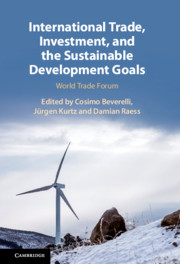Book contents
- International Trade, Investment, and the Sustainable Development Goals
- International Trade, Investment, and the Sustainable Development Goals
- Copyright page
- Contents
- Figures
- Tables
- Contributors
- Preface
- Introduction
- Part I Penetration and Diffusion of the Sustainable Development Goals
- Part II Top-Down: Public Approaches to Achieving the Sustainable Development Goals
- 4 The Trade Effects of Environmental Provisions in Preferential Trade Agreements
- 5 Facilitating Sustainable Investment
- Part III Bottom-Up: Private Sector and Civil Society Initiatives on the Sustainable Development Goals
- Index
- References
4 - The Trade Effects of Environmental Provisions in Preferential Trade Agreements
from Part II - Top-Down: Public Approaches to Achieving the Sustainable Development Goals
Published online by Cambridge University Press: 18 September 2020
- International Trade, Investment, and the Sustainable Development Goals
- International Trade, Investment, and the Sustainable Development Goals
- Copyright page
- Contents
- Figures
- Tables
- Contributors
- Preface
- Introduction
- Part I Penetration and Diffusion of the Sustainable Development Goals
- Part II Top-Down: Public Approaches to Achieving the Sustainable Development Goals
- 4 The Trade Effects of Environmental Provisions in Preferential Trade Agreements
- 5 Facilitating Sustainable Investment
- Part III Bottom-Up: Private Sector and Civil Society Initiatives on the Sustainable Development Goals
- Index
- References
Summary
The international community has acknowledged that international trade can be an effective means of helping to achieve the 2030 Agenda for Sustainable Development and its 17 Sustainable Development Goals (SDGs). Traditionally, preferential trade agreements (PTAs) were designed to promote trade flows. PTAs have become more comprehensive and now also cover non-economic policy areas, such as the environment. This chapter examines whether the inclusion of environmental provisions in PTAs changes the observed overall positive contribution that PTAs make to economic outcomes and thereby to the economic objectives of the SDGs. Specifically, we ask whether the inclusion of environmental provisions in PTAs reduces export flows between PTA partner countries. Using a novel data set on environmental provisions in PTAs, we estimate gravity type panel regressions. We find that membership in PTAs including more environmental provisions is associated with less trade among trade partners compared to PTAs that include less or no environmental provisions. This negative effect of environmental provisions is fully driven by the negative effect on South–North trade flows, i.e. exports from developing to high-income countries.
Keywords
- Type
- Chapter
- Information
- International Trade, Investment, and the Sustainable Development GoalsWorld Trade Forum, pp. 111 - 139Publisher: Cambridge University PressPrint publication year: 2020

